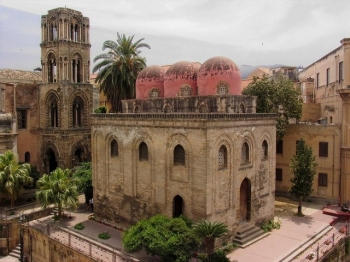The church of St. Cataldo in Palermo

A tiny piece of Puglia in the heart of Palermo. Not only because it is dedicated to the saint bishop of Taranto, but also because it was most likely part of the palace of an eminent 12th century figure, Grand Admiral Maione da Bari. His rank, in reality, had nothing to do with the sea; it corresponded to that of supreme adviser to the Norman king William I the Bad. After Maione’s death – in 1160 AD – the church was given by the king first to Silvestro da Marsico, who buried his daughter there in 1161, and then to the diocese of Monreale.
Like almost all ancient buildings, it has gone through many vicissitudes over the centuries, but has retained its original stylistic features, those of ArabNorman architecture. St. Cataldo looks like a cube, lightened by ogival windows and surmounted by three small red domes in a row, corresponding to the nave, higher than the two side aisles, divided by reused columns and capitals.
The interior is bare; the contrast with the rich polychrome marble floor in cosmatesque style has led to the suggestion that work was interrupted on Maione’s death. But this does not detract from its charm. The succession of ogival arches leading to the white marble altar with a central cross and the symbols of the evangelists create an evocative effect full of spirituality. Still preserved inside is the tombstone of Matilda, daughter of the building’s second owner. On the outside, in addition to the round domes, part of an openwork frieze running around the perimeter of the building bears witness to the Arab influence.
The church was donated in 1937 to the Knights of the Order of the Holy Sepulchre, who restored it with great care and ensure that it is open to the public for visits. On the way out, the nearby Martorana Church, which dates from the same period, could not show a more striking contrast; the original structures, those that give San Cataldo its essential character, were submerged by a very rich decoration in the Baroque period. One next to the other, two different ways of conceiving the house of the Lord.
(January 2022)



